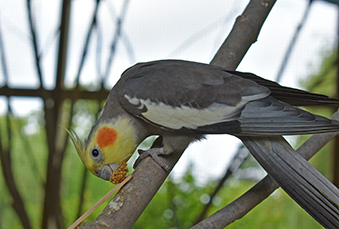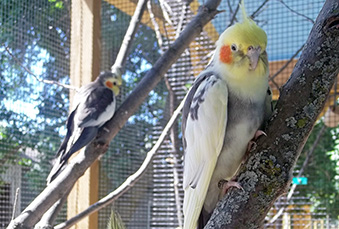Nymphicus hollandicus | Cockatiel
Names: Alfalfa & Rodeo (Males)



Meet the Cockatiels: Alfalfa and Rodeo!
Say hello to Alfalfa and Rodeo, our duo of lively cockatiels (Nymphicus hollandicus)! These small, social parrots are native to Australia and Tasmania, where they thrive in arid and semi-arid regions, always on the move in search of food and water. As members of the cockatoo family, cockatiels are the smallest of their kind but just as full of personality!
Flock Life & Feeding Habits
In the wild, cockatiels travel in flocks of up to 100 birds, staying close to water sources while feeding on seeds, grains, and insects. Their nomadic lifestyle helps them survive in Australia’s harsh environment.
At the zoo, Alfalfa and Rodeo enjoy a nutritious diet of cockatiel seed mix, Mazuri® small bird diet, and diced produce. Their bright colors and charming whistles make them a favorite among visitors!
A Crest That Speaks Volumes
One of the most expressive features of a cockatiel is its crest, which acts like a built-in mood indicator:
- Fully raised = Alert, curious, or excited
- Relaxed = Calm and content
- Flattened = Fear, aggression, or irritation
Cockatiels are also highly vocal, using calls and whistles to communicate within their flock. Males, in particular, are known for their mimicking abilities, imitating whistles, beeps, and even speech to attract mates or get attention.
Fact Sheet
Taxonomy
Species: hollandicus
Kingdom: Animalia | Phylum: Chordata | Class: Aves | Order: Psittaciformes | Family: Cacatuidae | Genus: Nymphicus |
Favorite Enrichment Type
Cardboard tubes to shred!
What We Sound Like
Life Span
- In the Wild: 10 to 14 years
- In Human Care: 15 to 25+ years
Diet
- In the Wild: Seeds, grains, and insects
- At the Zoo: Cockatiel seed mixture, Mazuri® small bird diet, and diced produce.
Geographic Range
Throughout mainland Australia and Tasmania.
Habitat
Arid and semi-arid regions of Australia.
Status: Least Concern
A Species at Risk
Though cockatiels are classified as Least Concern, their wild populations still face threats from habitat destruction and capture for the pet trade. While these birds are incredibly popular as pets, the demand for exotic birds has led to illegal wild-capture and smuggling, which disrupts wild populations and often results in poor conditions for the birds.
Not a Pet: The Reality of Cockatiel Care
Cockatiels may be small, but they are a huge commitment for anyone considering adding them to their family. Many people underestimate their needs, leading to birds being rehomed or abandoned. Here are just a few things that must be taken into consideration:
- Lifespan: They can live 15 – 25+ years with proper care. That’s a long commitment!
- Social Needs: Cockatiels require daily interaction and can become lonely or develop behavioral issues if neglected.
- Noise Level: They are vocal birds and can be quite loud, especially in the morning and evening.
- Mess and Dust: Cockatiels produce feather dust, which can trigger allergies, and they create a mess when eating or playing.
- Time and Enrichment: They need plenty of space, toys, and mental stimulation to stay happy and healthy.
If you would like to learn more about why domestic animals are the best pets for most people, check out the Not-a-Pet campaign!
Support Conservation, Not the Illegal Pet Trade
Many pet birds, including cockatiels, suffer due to irresponsible breeding and illegal trade. While cockatiels are bred by humans worldwide, wild bird poaching remains a serious issue for many species. If you are considering adding a cockatiel to your family, remember to adopt, don’t shop from irresponsible sources, and never support the illegal pet trade!
Alfalfa and Rodeo may be small, but they have huge personalities and help us teach visitors about their counterparts in the wild. So next time you visit, listen to their cheerful whistles and watch their expressive crests in action!
How to Find Me
Looking to meet Wedgie? Head on over to our Aviary, nestled between our Outback viewing deck and the white-throated capuchin habitat. You can find her in one of the side habitats, viewable from the outback viewing deck! If in a talkative mood, you will be able to hear her throughout the zoo!
